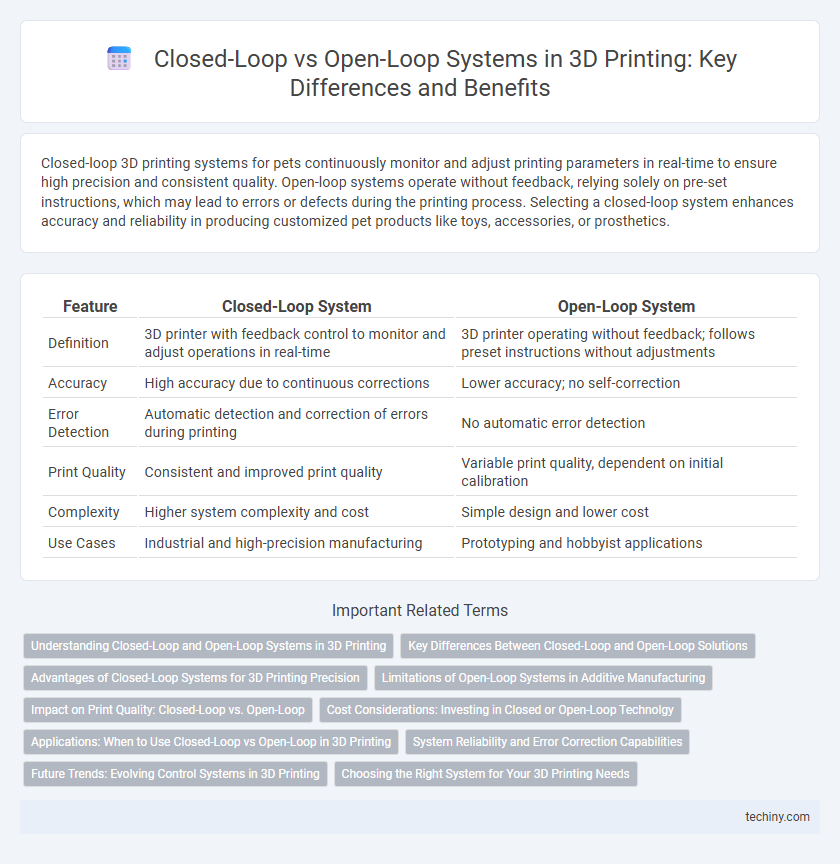Closed-loop 3D printing systems for pets continuously monitor and adjust printing parameters in real-time to ensure high precision and consistent quality. Open-loop systems operate without feedback, relying solely on pre-set instructions, which may lead to errors or defects during the printing process. Selecting a closed-loop system enhances accuracy and reliability in producing customized pet products like toys, accessories, or prosthetics.
Table of Comparison
| Feature | Closed-Loop System | Open-Loop System |
|---|---|---|
| Definition | 3D printer with feedback control to monitor and adjust operations in real-time | 3D printer operating without feedback; follows preset instructions without adjustments |
| Accuracy | High accuracy due to continuous corrections | Lower accuracy; no self-correction |
| Error Detection | Automatic detection and correction of errors during printing | No automatic error detection |
| Print Quality | Consistent and improved print quality | Variable print quality, dependent on initial calibration |
| Complexity | Higher system complexity and cost | Simple design and lower cost |
| Use Cases | Industrial and high-precision manufacturing | Prototyping and hobbyist applications |
Understanding Closed-Loop and Open-Loop Systems in 3D Printing
Closed-loop systems in 3D printing continuously monitor and adjust printing parameters through feedback sensors, ensuring higher precision and consistency in layer deposition, which reduces errors and material waste. Open-loop systems operate without real-time adjustments, relying solely on pre-set instructions, making them simpler but more prone to inaccuracies during complex prints. Understanding the distinctions between these systems is crucial for optimizing print quality and minimizing defects in additive manufacturing processes.
Key Differences Between Closed-Loop and Open-Loop Solutions
Closed-loop 3D printing systems continuously monitor and adjust printing parameters based on real-time feedback, ensuring higher precision, reduced material waste, and improved print quality compared to open-loop systems. Open-loop systems operate without feedback mechanisms, relying solely on pre-set instructions, which can result in errors and inconsistencies during the printing process. The integration of sensors and control algorithms in closed-loop solutions enables adaptive corrections, making them more suitable for complex and high-accuracy additive manufacturing applications.
Advantages of Closed-Loop Systems for 3D Printing Precision
Closed-loop systems in 3D printing utilize real-time feedback sensors to continuously monitor and adjust printing parameters, significantly enhancing dimensional accuracy and reducing errors. This dynamic control minimizes material waste and improves surface finish consistency compared to open-loop systems that operate without feedback correction. The integration of closed-loop control technology supports higher repeatability, making it ideal for complex and high-precision additive manufacturing applications.
Limitations of Open-Loop Systems in Additive Manufacturing
Open-loop systems in additive manufacturing lack real-time feedback, resulting in limited error detection and correction during the 3D printing process. This absence of monitoring often leads to increased defects, dimensional inaccuracies, and material waste. Consequently, open-loop systems hinder the optimization of print quality and consistency compared to closed-loop systems.
Impact on Print Quality: Closed-Loop vs. Open-Loop
Closed-loop systems in 3D printing continuously monitor and adjust parameters such as temperature, extrusion rate, and layer alignment, significantly enhancing print quality by minimizing errors and material waste. In contrast, open-loop systems operate without real-time feedback, making them more prone to inaccuracies like layer misalignment and inconsistent extrusion, which degrade the final print surface and dimensional precision. The integration of sensors and feedback mechanisms in closed-loop systems ensures higher reliability and repeatability in complex or high-precision prints.
Cost Considerations: Investing in Closed or Open-Loop Technolgy
Closed-loop 3D printing systems often require higher initial investment due to advanced sensors and feedback controls that enhance precision and reduce material waste. Open-loop systems have lower upfront costs but may incur higher long-term expenses from material inefficiencies and quality inconsistencies. Evaluating cost considerations involves balancing the upfront capital expenditure against potential savings in maintenance, material usage, and product quality assurance.
Applications: When to Use Closed-Loop vs Open-Loop in 3D Printing
Closed-loop systems in 3D printing are essential for applications requiring high precision and real-time error correction, such as aerospace component manufacturing and medical device prototyping. Open-loop systems are suitable for less critical tasks like hobbyist projects or rapid prototyping where speed and simplicity outweigh the need for constant monitoring. Selecting between closed-loop and open-loop depends on the desired quality control, cost considerations, and application-specific accuracy requirements.
System Reliability and Error Correction Capabilities
Closed-loop 3D printing systems continuously monitor printing parameters through sensors, enabling real-time error detection and correction, which significantly enhances system reliability and print quality. In contrast, open-loop systems lack feedback mechanisms, resulting in higher susceptibility to process deviations and lower error correction capabilities. This difference makes closed-loop systems more suitable for applications demanding precision and consistent performance.
Future Trends: Evolving Control Systems in 3D Printing
Future trends in 3D printing emphasize the shift from open-loop to closed-loop control systems, enhancing precision and reliability by integrating real-time sensor feedback and adaptive process adjustments. Closed-loop systems utilize advanced machine learning algorithms and AI-driven monitoring to detect defects early and optimize print quality dynamically. This evolution enables greater automation, reduces material waste, and supports the production of complex geometries with consistent accuracy in additive manufacturing.
Choosing the Right System for Your 3D Printing Needs
Selecting the right system for 3D printing depends on the specific requirements for precision, control, and cost-efficiency. Closed-loop systems offer real-time feedback and adjustments through sensors and controllers, ensuring higher accuracy and reduced errors in complex manufacturing processes. Open-loop systems operate without feedback control, making them more affordable and sufficient for simpler, less critical applications where precision is not the primary concern.
Closed-Loop System vs Open-Loop System Infographic

 techiny.com
techiny.com